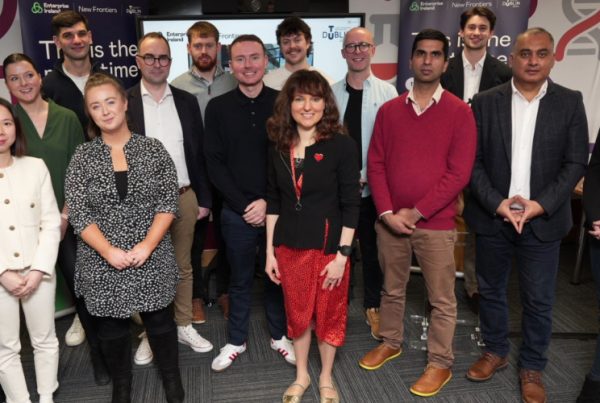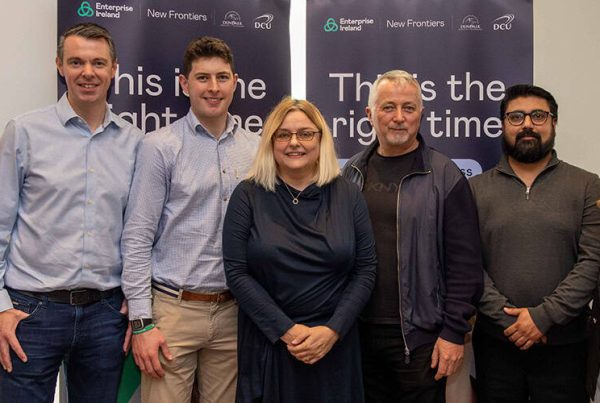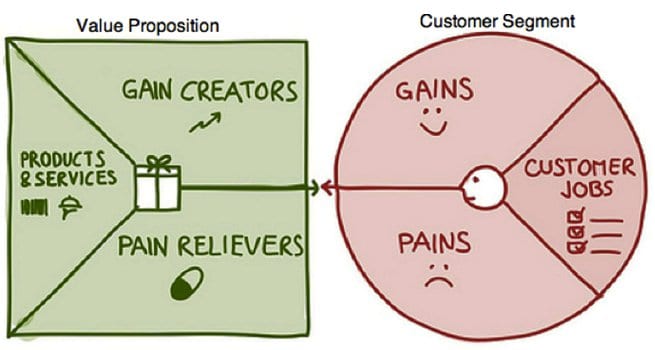
A Unique Value Proposition (UVP) is extremely important for every startup business. It is the answer to the question: What is it that makes your product or service different, unique and most importantly will persuade people to buy from you? The problem for early-stage promoters is defining the essence of their solution and communicating it concisely. This article will outline a process for crafting your Value Proposition and outline some examples from participants on New Frontiers programmes.
UVP is a critical component of any marketing strategy
A strong value proposition is the first step in deciding how a business is going to market its solution. It goes to the heart of what the business does (or does not do) and why that matters to customers. One of the primary objectives of marketing is to generate awareness of and interest in your solution in a target market that is being constantly bombarded with marketing messages.
Ash Maurya, author of Running Lean holds that the definition of UVP needs to be redefined. He challenges startups to ‘distil the essence of your product in a few words that can fit in the headline of your landing page’.
First-time visitors spend eight seconds on average on a landing page. Your UVP is their first interaction with your product. Craft a good UVP and they might stay and view the rest of your site. Otherwise they’ll simply leave.
Ash Maurya, Running Lean
Remember, you’re not trying to tell the entire story in one line, but get across that you have a story worth considering. The reaction to your UVP should be ‘How does it do that?’ or ‘Tell me more’.
 Value Proposition Canvas
Value Proposition Canvas
I use this value Proposition canvas from the Business Model Foundry as an exercise with Phase 2 participants in Tralee and Dundalk IT and it has received great feedback as it provides a structure for considering all elements. My advice is to start with the Customer Segment and the jobs that customers want done and then work through the rest. Then write your one or two line UVP.
There is a detailed explanation of all six elements in the Canvas in their pdf download.
A UVP Formula
The classic formula for crafting your UVP is:
Instant Clarity Headline = End Result Customer Wants (+ Special Period of Time + Address the Objections)
And the classic example of this formula in action is:
Hot fresh pizza delivered to your door in 30 minutes or it’s free (Dominos)
The entire formula won’t be relevant or applicable in every situation, but the headline should definitely reference the target customer and their wants. It is also important to consider if the objections of the target buyer can be addressed.
Crafting your UVP
When creating your UVP, the key is to focus on the benefits your customers derive from your product. These ‘finished story benefits’ will ensure that your UVP gets inside the heads of your customers. For example, consider how to formulate the proposition of a resume-building service:
- Feature: professionally designed templates
- Benefit: eye-catching CV
- Finished story benefit: landing your dream job
I think that the finished story benefit will definitely grab attention. It is then up to your product solution to deliver, which is a sure way to delight your customer.
Test and refine your UVP
The first step in testing your proposition is to discuss it with a trusted business advisor or mentor. It is also important to verify your customer assumptions, so you’ll need to engage with as many customers as you can and find out if their priorities, pains and gains are as you have described them. Once you have done this, you’ll be able to tweak or even change your proposition based on these insights. Here’s a great example:
I don’t play golf, but I love Golf Voyager’s value proposition. The key problem they are trying to solve is the hassle involved in organised group golf trips. A New Frontiers business in Limerick in 2013, they have a brilliant hook to their model in that they pay part of your next year’s golf membership if you book trips and hotel stays through their website:
“Book all your hotel stays and golf holidays through Golf Voyager and save on your membership fees next year.”
My Conclusion and Call to Action
One of my favourite quotes from a business book that I highly recommend, The Jelly Effect, is:
AFTERs – People don’t care what you do. They only care about what they are left with after you have done it.
Andy Bounds, The Jelly Effect
This might seem a bit harsh, but it’s definitely true! My final example is from Olive O’Connor, a New Frontiers participant in 2013, who has developed a Filofax-type medical organiser for people and carers managing chronic illnesses. The MediStori gives people who don’t wish to use technology an easy-to-use, paper-based solution. On one level, this allows people to record their medical history and keep a daily medical record which can be easily shared, and on another level it gives them back a sense of control over their own lives. The result is a prototype that has garnered endorsements from charities, doctors, pharmacists and patient groups. Olive has used her UVP to produce a video to promote MediStori (see below).
My challenge to you is to craft a value proposition that works for your business. I hope that you find the UVP formula and the value proposition canvas useful as you set about this task!
About the author
 Donncha Hughes
Donncha Hughes
Donncha Hughes is a former incubation centre manager and has worked with startups for almost ten years. A big advocate of Lean Startup, his areas of expertise include: marketing, sales, business models, supports for business, business plans and financial projections. An EI mentor and member of the CSF Evaluation Panel, Donncha specialises in working with early stage startups.
Recent articles

Founder Perspectives: Lessons From Building Businesses In Sustainability

Tech Startups In The Age Of AI: Alumnus Paul Savage On Speed, Quality & Risk

Fourteen Startup Founders Graduate From Phase 2 Of New Frontiers In Tallaght

Eleven Founders Graduate From New Frontiers In The Border Mid-East Region

Laying The Right Groundwork Helps Startups Prepare For Export Success

Startup In Dublin: Learn More About New Frontiers On TU Dublin’s Grangegorman Campus

Michael Furey On The Success Of Ronspot: “The Most Important Thing Is Research”

 Value Proposition Canvas
Value Proposition Canvas Donncha Hughes
Donncha Hughes
